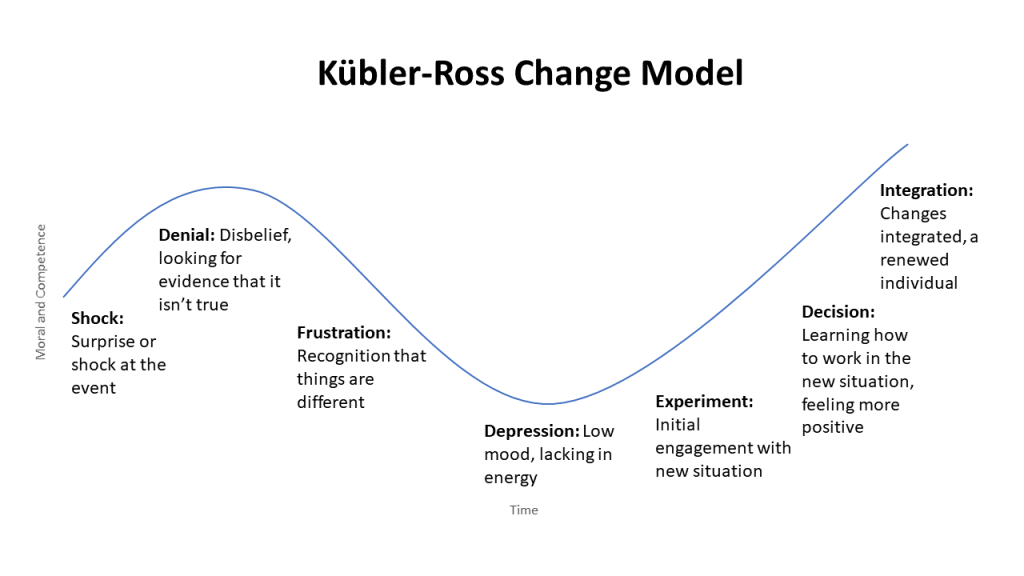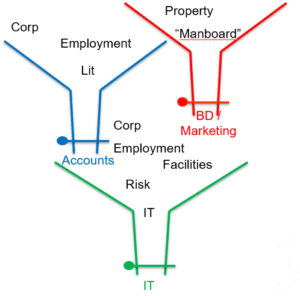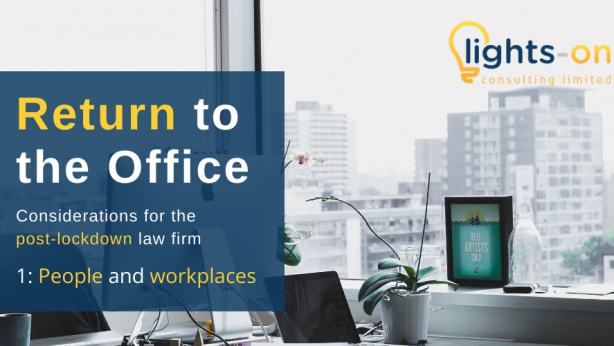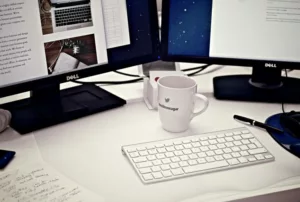A law firm is its people. Even firms that heavily “productise” work rely on the skills, output and throughput of their people, so it is appropriate that we start with people in this series of discussion papers about the return to office working.
We briefly explore some elements of the people impact returning to the office and also the impact of the continuance of remote working or blend of the two (“bi-modal” operations). In the articles to follow, we will look through the lenses of IT service, technology, governance and working practices.
 Reference to the Kübler-Ross model in our introduction article may imply a linear transition but people can be affected by many “phased waves” of managing change as we return to office working. For example, they could be at the tail (“integration”) end of one curve adapting to home working but be in a completely different position on other aspects such as frustration in travel arrangements or fear about using public transport.
Reference to the Kübler-Ross model in our introduction article may imply a linear transition but people can be affected by many “phased waves” of managing change as we return to office working. For example, they could be at the tail (“integration”) end of one curve adapting to home working but be in a completely different position on other aspects such as frustration in travel arrangements or fear about using public transport.
Your people’s perceptions will be driven by many individual factors including their own attitude to risk and personal circumstances. The result is a wide spectrum of how people will react if and when they are asked to return to office working, which is likely to be more complicated than the switch to remote working at the start of the pandemic!
It is clear from press and medical reports that mental health is a serious issue with quite widespread impact showing as different and poor sleep patterns, job stress, fears and concerns for personal wellbeing and that of the family and financial worries from fear of furlough, redundancy and longer term financial impact on the likes of pensions and investments.
In recent history, there appears never to have been a more important time for employers’ consideration of individual and collective wellbeing of its people at a time when commercial pressures will also drive a firm’s priorities.
This paper touches on some of the issues to promote discussion and ideation – It is not trying to be “the answer”.
First Steps – take control of communications
Be prepared for staff to be more confused and less tolerant of “return to the office” as they were with being sent home. Talk to your staff – either using a questionnaire or scripted / structured calls – to understand their sentiment towards returning to the office and any practical reasons that might require them to continue working from home.
It is essential to demonstrate that you understand government guidance and can explain very clearly your ‘return to office’ plan – and how this affects and supports all partners and staff.
Workload and bi-modal operation considerations
The successful operations of the firm back in the office will require considerable planning and co-ordination of all functions but particularly business support. How will you manage those support functions when their “customers” will most likely be operating in a blend of office and home-working?
Whilst we recognise that all teams and departments are affected, we single out IT as the IT team is often at the bottom of many “cascading funnels” of work requests.

This is happening at a time of increased technical complexity, home working, bi-modal operation and social distancing challenges in the office. The IT team is likely to be hit hard at a time when it too is trying to accommodate its own issues possibly with a furloughed headcount.
IT leadership must plan for more waves of heightened IT demand and should assess demand and complexity and consider un-furloughing required staff or even bringing in additional support in preparation for heightened demand and in plenty of time for preparatory work.
A New Office Operating Model
To comply with social distancing, offices will need to be sparsely populated initially and teams will consist of a blend of office and home workers. Return to office planning must consider a non-linear progression and must prepare for waves of lockdowns forcing a return to home working as well as preparing for the new office norm of a longer-term hybrid location approach as firms see the benefits and potential savings.
In the office
- Office redesign – We will leave office re-design to others far more equipped to comment however you must examine the impact on people and the IT impact of any re-configuration. Getting this right and establishing processes to manage it will take time so start now. The 2m rule may for some firms require a complete re-configuration of the office floorplate. Many firms are planning for between only 25% to 30% occupancy initially due mainly to desk layout, corridor size and communal area issues. Consider what your split of IT staff will be to support this bi-modal operation with only 25% of staff in the office. All support departments should brainstorm how it will support different configurations and draw up plans.
- Cleaning – Whilst the government recommends against hot desking currently this still may not negate the need for daily deep-cleans and the provision of anti-viral equipment wipes and sanitisers will be required. Watch out for sprays and the impact on IT kit and avoid them!
- Multi Office Extended Hours – The lockdown has meant that a single 80-person office firm has morphed into a firm with “80 offices” thus facing a challenge normally reserved for much larger firms. Homeworkers may have shared parental and home-schooling care leading to shift or weekend working, so the smaller firm is now also facing extended hours of demand on its IT teams. To support teams, it may feel like it has changed from supporting one office 8am-6pm Monday-Friday to 80 offices 24×7 so consider what will the long-term effect of this be on the office model of the future and plan.
- Office Productivity – This may have dipped initially before recovering as lawyers settle in to working remotely. Avoiding commuting may allow for a longer fee-earning day so will the office really be more productive? Repopulation of tall buildings and lift issues are obvious, but it is easy to miss the fact that 2 metre queuing for sandwiches in a busy city could result in people being out of the office for hours to get breakfast or lunch! Firms should be aware of the “food infrastructure” and “competition” in the surrounding area and what will be required to maintain productivity of office-based staff. Failure to look at this may mean staff request to return back home to work.
- Super Users – The normal “super user” support regime where the 1st port of call is the “secretary next door” may be impaired by social distancing so consider granting those super-users the same sort of screen takeover tools that the service desk has (with appropriate security rights and training) so that localised in-team support can continue.
- Collaboration – Relationships between Facilities and IT were not previously strong, now is the time work at those relationships as close and supportive collaboration will be key. The same is true for all teams.
Home workers
- Health and Safety and IT equipment – Ironically some H&S has gone out of the window in the short-term with very few home workstation assessments. More frequent and prolonged use will bring greater obligation to carry H&S audits and self-assessments to look after people’s wellbeing. Check your ability to handle this en-masse. Consider ‘home worker kits’ to prevent the need for transporting equipment to and from the office. This may necessitate the use of 2nd life equipment to make it affordable which brings its own support issues. Consider a policy of retaining old equipment as spares or for home use.
- Policy –Prolonged home working and use of 2nd life equipment will bring electrical testing and likely increased liability considerations such as insurance and loss cover. Update your policies and procedures for bi-modal operation. In a similar vein, occasional use of IT equipment at home rarely triggers requests for broadband, gas and electricity contributions but prolonged use is likely to necessitate a review of policy to support home users. Items to consider will be home office use, electricity, gas, broadband, use of personal phone, stationary, ink cartridges and loss of other in-office benefits such as gym, lunches etc. How should this be managed going forward with a blend of in-office and home-workers?
- Managing remote teams – Psychologically, if a substantive number of people in a team are back on-site, those left working remotely may unintentionally start to be treated as “on holiday”. Line managers must watch for this and adopt a widely inclusive approach to management. A daily video call “check in” meeting for those that can make it provides a connection for remote workers, together with regular and consistent feedback.

- Flexible working – With parents juggling childcare, home-schooling and limitations on office space due to distancing, it may be time to consider changes to working patterns. Some firms have embraced a policy of working where and when you want rather than 9-5 at your desk and are finding productivity and morale both increase. This may have an impact on support times for business service teams and weekend working or elongated service hours may be required that could impact of staffing numbers.
- Furloughed staff – Re-onboarding furloughed staff will need careful management. It will not just be a case of re-activating their accounts. They may be many months behind on the firm’s new modus operandi and IT tools so offer training to cover all remote tools and share the tips that colleagues have found to work well. Those furloughed may hold concerns about being re-furloughed or redundancy so careful management will be required to support the individuals and protect the firm from key person risks.
- Rotation of furloughed staff (where individuals are ‘rotated’ between being in work or on furlough) is likely to bring increased demand for both management and business services support as people have to continuously grapple with changes in layout, work support and technology. With the furlough scheme now extended to the end of October, a rotation scheme may become more widely used. Be prepared for additional demands if your firm is considering rotating furloughed staff.
- Training – How will this be delivered? What new approaches and technology will work? Some firms have furloughed their IT trainers and we would advocate that now is the time to have them engaging with people and providing IT support / training and developing training approaches that will survive a change in modus operandi. Many larger firms with centralised support models already utilise online conferencing tools to deliver training to remote offices but the approach transcends to smaller firms too so consider.
- Trainees – How do trainees gain experience in a remote world? Is the shadowing/mentoring set-up still a viable option and what is your firm’s plan? Trainee intake/ onboarding of new joiners normally occurs in September so ensure you can design the new IT and HR approach to onboard these new trainees if a remote working environment remains in force.
IT team preparations
IT teams have worked hard and fast to deliver home working but what will the next demands on the team be and how should leaders prepare for what is next?
The team must support a new, bi-modal business model. Until now “Bi-modal” differentiated between innovation and business as usual IT but we use it here in relation to in-office and home-working, which may become a more permanent blend as firms look to future proof the firm and re-examine their office break clauses if productivity and output has remained relatively high whilst home working.
How will IT leadership manage the team when it is becoming clear that it will be difficult to mandate attendance at the office for quite some time to come? We outline some thoughts below:
- Training – Can we use what has happened to transform how we train people? What doors to training have been opened up to us and what new approaches and technology will work? You should examine “re-packaging” your training offering now as demand is just around the corner.
- The Return of Printing ? – It is sad to say that all wars advance technology and this war against a virus is doing the same. Widescale adoption of video conferencing has taken place and a new “paperless” way of working has been forced upon us with lawyers reviewing contracts on screen and e-signing. If printer-less and paper-free working is possible, is now the time to bite the bullet and severely restrict (or even work to remove) printing in the office? Bold firms can benefit from such a change.
- High Tempo Expectation Management – Your team has pulled out the stops under difficult circumstances and delivered in days or weeks all sorts of solutions that would normally take months. What will be the expectation of you and your team going forward? Your people may have been forced cut corners to meet deadlines but now we will have to contend with delivering to the expectation of a high tempo whilst bringing back in the governance we may have foregone. Communications are required to explain honestly what has been skipped and now needs correcting and to manage expectations of speed as we change the race from a sprint to a marathon.
- Having an Amnesty – Tech savvy lawyers will have found very innovative ways of collaborating and sharing with other parties and how to work remotely “offline”. They may have even tried the odd YouTube hack here there to work
around governance that makes remote life difficult. What do you do about these?- Survey your end users (and the IT staff!) confidentially to find out what was good and what got in the way of working and whether they found work arounds or “hacks” to the system to make them work better for them. Try to accommodate these in the next design but also establish a programme to “tidy up” potential loopholes including documents saved to desktops, printouts at home etc. This will be especially useful if the lockdown process repeats.
- Assess how changes made during lockdown might form part of your ongoing strategy, where tools and techniques can be rolled out to all – either for ‘business as usual’ or for use in unusual/emergency situations. Have any changes highlighted gaps in your IT offering or in the security and management of this, that should be address in the firm’s IT strategy?
Closing remarks
We can only touch on some examples to stimulate thought in an article like this but we feel the main themes are:
- Engage in collective brainstorming and planning to “road test” your plans.
- Understand that work from home does not mean “rested” and people are burned out, “Teamed out” or “zoomed out”! Many have gone the extra mile to deliver either internal or external service during pressured time. You may have already recognised that but it may be worth re-iterating that as return to the office effort will also take its toll.
- Communicate plans clearly but expect people to behave very differently. Line managers will need to be very aware of their own and their team members’ mental health and resilience.
- Plan for hybrid bi-modal working with a non-linear ebb and flow between office and home working.
- Recognise that the “cement will soon set” on old ways of working unless you take substantial and positive action when people return to realise the benefits of new ways of working.
- Like a holiday, expect the return journey to seem longer and less rewarding and expect that those making the journey with you may not be in the best of spirits!


